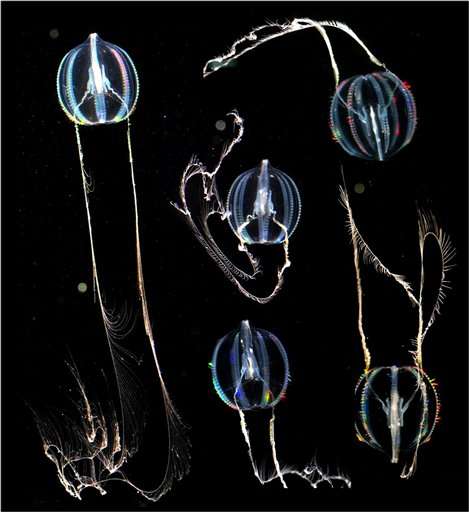'Aliens of sea' provide new insight into evolution

Exotic sea creatures called comb jellies may reshape how scientists view early evolution—as their genes suggest nature created more than one way to make a nervous system.
These beautiful but little-known translucent animals often are called "aliens of the sea," for good reason. Somehow, they rapidly regenerate lost body parts. Some even can regrow a very rudimentary brain.
Now in an in-depth look at the genes of 10 comb jelly species, researchers report that these mysterious creatures evolved a unique nervous system in a completely different way than the rest of the animal kingdom.
In other words, the nervous system evolved more than once, a finding published Wednesday by the journal Nature that challenges long-standing theories about animal development.
"This paper proves, on a genomic basis, they're truly aliens," said University of Florida neurobiologist Leonid Moroz, whose team spent seven years unraveling the genetics behind comb jellies' neural programming.
But the findings aren't just about evolutionary history. Comb jellies build a nervous system essentially using their own biological language, Moroz explained. That points to new ways to investigate brain diseases such as Alzheimer's or Parkinson's—maybe even, one day, the ability to engineer new neurons, Moroz said.
They "open to us completely unexpected windows," he said.
Moroz is exploring some of those windows using a unique floating laboratory that allows sophisticated genomic sequencing at sea. In a test run off the coast of Florida this spring, The Associated Press documented how his team is studying which genes switch on and off as iridescent comb jellies regenerate from injury.
All animals evolved from a single ancestor. Scientists want to determine which branches broke off first, and how the earliest animals gradually changed to become more complex. The general theory: The oldest animals were the simplest, and once neural systems emerged, they evolved in a straightforward path from primitive nerve nets up to complex human brains.

Moroz's team offered a dramatically different explanation.
The researchers mapped the full genetic code of the Pacific sea gooseberry, the nickname for a comb jelly species known as Pleurobrachia bachei. They also decoded gene activity of nine additional species of ctenophores—the scientific name for comb jellies. (The "c'' is silent.)
First, they found comb jellies represent the oldest branch of the animal family tree—not the simpler sea sponges traditionally thought to hold that spot, the team reported. That bolsters a similar finding published last December by competing scientists from the National Institutes of Health, which had been greeted with some skepticism.
And it's important in this context because sponges don't have neurons.
So what happened? Parallel evolution, Moroz proposed: While other branches of the animal family tree shared one path, the comb jellies essentially went down another street as they developed circuits of neurons, nerve cells that control such functions as motion and behavior. They simply don't have many of the genes that other animals use for neural development and function.
The results were "really weird," Moroz said. "Everybody from jellyfish to us have the same alphabet" when neurons communicate—but not the more ancient comb jellies.
For example, ctenophores don't use serotonin, dopamine and other common signaling chemicals, called neurotransmitters. Instead, they use methods unique to them.
"They're presenting data that's quite powerful," said biologist Antonis Rokas of Vanderbilt University, who wasn't part of the new work.
"It's almost like evolution has given us two different blueprints for building a structure that's very important," he added. "If your goal is to make a nervous system, it doesn't matter what the parts are in some ways. You could potentially mix and match. The more parts you have, the more solutions."
More information: The ctenophore genome and the evolutionary origins of neural systems, Nature, 2014. DOI: 10.1038/nature13400
Journal information: Nature
© 2014 The Associated Press. All rights reserved.



















